Lava Mapping Using Sentinel-1 Data after the Occurrence of a Volcanic Eruption—The Case of Cumbre Vieja Eruption on La Palma, Canary Islands, Spain
Abstract
:1. Introduction
2. Materials and Methods
2.1. Area of Interest—La Palma Volcanic Eruption
2.2. SAR Data
2.3. Methods Applied
3. Results
3.1. SAR Interferometry
3.2. Offset Tracking
4. Discussion
5. Conclusions
- Sentinel-1 interferograms are able to capture ground deformation related to either (a) the upwelling of magma and ground inflation a few days before the eruption, or (b) the eruptive phase.
- The relative movement towards the satellite indicated ground inflation prior to the upcoming eruption, while post-eruption deflation was accompanied by a relative movement away from the satellite.
- The multitemporal evolution of LOS displacements throughout the entire eruptive period was linked to the various eruptive phases (i.e., inflation–deflation, crystallization and cooling, etc.).
- Offset tracking was successfully used to monitor the evolution of lava flows on the island throughout the entire eruptive period.
- High lava velocities (>2 m/day) were detected.
- The analysis of the evolution of lava flows contributed to achieving a better understanding of the volcanic processes.
Author Contributions
Funding
Institutional Review Board Statement
Informed Consent Statement
Data Availability Statement
Acknowledgments
Conflicts of Interest
References
- World Health Organization. Volcanic Eruptions. Available online: https://www.who.int/health-topics/volcanic-eruptions#tab=tab_1 (accessed on 21 July 2022).
- Del Negro, C.; Cappello, A.; Neri, M.; Bilotta, G.; Hérault, A.; Ganci, G. Lava flow hazards at Mount Etna: Constraints imposed by eruptive history and numerical simulations. Sci. Rep. 2013, 3, 3493. [Google Scholar] [CrossRef] [PubMed] [Green Version]
- Del Negro, C.; Cappello, A.; Bilotta, G.; Ganci, G.; Hérault, A.; Zago, V. Living at the edge of an active volcano: Risk from lava flows on Mt. Etna. GSA Bull. 2020, 132, 1615–1625. [Google Scholar] [CrossRef]
- Jenkins, S.F.; Day, S.J.; Faria, B.V.E.; Fonseca, J.F.B.D. Damage from lava flows: Insights from the 2014–2015 eruption of Fogo, Cape Verde. J. Appl. Volcanol. 2017, 6, 6. [Google Scholar] [CrossRef]
- Blackett, M. An Overview of Infrared Remote Sensing of Volcanic Activity. J. Imaging 2017, 3, 13. [Google Scholar] [CrossRef] [Green Version]
- Pyle, D.M.; Mather, T.A.; Biggs, J. Remote sensing of volcanoes and volcanic processes: Integrating observation and modelling-introduction. Geol. Soc. Spec. Publ. 2013, 380, 1–13. [Google Scholar] [CrossRef]
- Francis, P.W.; Wadge, G.; Mouginis-Mark, P.J. Satellite Monitoring of Volcanoes. In Monitoring and Mitigation of Volcano Hazards; Springer: Berlin/Heidelberg, Germany, 1996. [Google Scholar] [CrossRef]
- Duda, K.A.; Ramsey, M.; Wessels, R.; Dehn, J. Optical Satellite Volcano Monitoring: A Multi-Sensor Rapid Response System. In Geoscience and Remote Sensing; IntechOpen: London, UK, 2009. [Google Scholar] [CrossRef] [Green Version]
- Kereszturi, G.; Schaefer, L.N.; Schleiffarth, W.K.; Procter, J.; Pullanagari, R.R.; Mead, S.; Kennedy, B. Integrating airborne hyperspectral imagery and LiDAR for volcano mapping and monitoring through image classification. Int. J. Appl. Earth Obs. Geoinf. 2018, 73, 323–339. [Google Scholar] [CrossRef]
- Lu, Z.; Fielding, E.; Patrick, M.; Trautwein, C. Lava volume estimated by precision combination of multiple baseline space-borne and airborne interferometric synthetic aperture radar: Application to the 1997 eruption of Okmok Volcano, Alaska. IEEE Trans. Geosci. Remote Sens. 2003, 41, 1428–1436. [Google Scholar]
- Rowland, S.K.; Harris, A.J.L.; Wooster, M.J.; Amelung, F.; Garbeil, H.; Wilson, L.; Mouginis-Mark, P.J. Volumetric characteristics of lava flows from interferometric radar and multispectral satellite data: The 1995 Fernandina and 1998 Cerro Azul eruptions in the western Galapagos. Bull. Volcanol. 2003, 65, 311–330. [Google Scholar] [CrossRef]
- Pinel, V.; Poland, M.; Hooper, A. Volcanology: Lessons learned from Synthetic Aperture Radar imagery. J. Volcanol. Geotherm. Res. 2014, 289, 81–113. [Google Scholar] [CrossRef]
- Lu, Z.; Rykhus, R.; Masterlark, T.; Dean, K.G. Mapping recent lava flows at Westdahl Volcano, Alaska, using radar and optical satellite imagery. Remote Sens. Environ. 2004, 91, 345–353. [Google Scholar] [CrossRef]
- Kervyn, M.; Kervyn, F.; Goossens, R.; Rowland, S.K.; Ernst, G.G.J. Mapping volcanic terrain using high-resolution and 3D satellite remote sensing. Geol. Soc. Spec. Publ. 2007, 283, 5–30. [Google Scholar] [CrossRef]
- Dietterich, H.R.; Poland, M.P.; Schmidt, D.A.; Cashman, K.V.; Sherrod, D.R.; Espinosa, A.T. Tracking lava flow emplacement on the east rift zone of Klauea, Hawaii, with synthetic aperture radar coherence. Geochem. Geophys. Geosyst. 2012, 13, 1–17. [Google Scholar] [CrossRef]
- Boccardo, P.; Gentile, V.; Tonolo, F.G.; Grandoni, D.; Vassileva, M. Multitemporal SAR coherence analysis: Lava flow monitoring case study. In Proceedings of the International Geoscience and Remote Sensing Symposium (IGARSS), Milan, Italy, 26–31 July 2015; pp. 2699–2702. [Google Scholar] [CrossRef]
- Ebmeier, S.K.; Biggs, J.; Mather, T.A.; Elliott, J.R.; Wadge, G.; Amelung, F. Measuring large topographic change with InSAR: Lava thicknesses, extrusion rate and subsidence rate at Santiaguito volcano, Guatemala. Earth Planet. Sci. Lett. 2012, 335–336, 216–225. [Google Scholar] [CrossRef] [Green Version]
- Richter, N.; Poland, M.P.; Lundgren, P.R. TerraSAR-X interferometry reveals small-scale deformation associated with the summit eruption of Kīlauea Volcano, Hawai’i. Geophys. Res. Lett. 2013, 40, 1279–1283. [Google Scholar] [CrossRef]
- Wittmann, W.; Sigmundsson, F.; Dumont, S.; Lavallée, Y. Post-emplacement cooling and contraction of lava flows: InSAR observations and a thermal model for lava fields at Hekla volcano, Iceland. J. Geophys. Res. Solid Earth 2017, 122, 946–965. [Google Scholar] [CrossRef] [Green Version]
- González, P.J.; Bagnardi, M.; Hooper, A.J.; Larsen, Y.; Marinkovic, P.; Samsonov, S.V.; Wright, T.J. The 2014–2015 eruption of Fogo volcano: Geodetic modeling of Sentinel-1 TOPS interferometry. Geophys. Res. Lett. 2015, 42, 9239–9246. [Google Scholar] [CrossRef] [Green Version]
- Babu, A.; Kumar, S. PSInSAR Processing for Volcanic Ground Deformation Monitoring Over Fogo Island. Proceedings 2019, 24, 6217. [Google Scholar] [CrossRef] [Green Version]
- Papageorgiou, E.; Foumelis, M.; Trasatti, E.; Ventura, G.; Raucoules, D.; Mouratidis, A. Multi-Sensor SAR Geodetic Imaging and Modelling of Santorini Volcano Post-Unrest Response. Remote Sens. 2019, 11, 259. [Google Scholar] [CrossRef]
- Pritchard, M.E.; Biggs, J.; Wauthier, C.; Sansosti, E.; Arnold, D.W.D.; Delgado, F.; Ebmeier, S.K.; Henderson, S.T.; Stephens, K.; Cooper, C.; et al. Towards coordinated regional multi-satellite InSAR volcano observations: Results from the Latin America pilot project. J. Appl. Volcanol. 2018, 7, 1–28. [Google Scholar] [CrossRef] [Green Version]
- Bignami, C.; Chini, M.; Amici, S.; Trasatti, E. Synergic Use of Multi-Sensor Satellite Data for Volcanic Hazards Monitoring: The Fogo (Cape Verde) 2014–2015 Effusive Eruption. Front. Earth Sci. 2020, 8, 22. [Google Scholar] [CrossRef] [Green Version]
- Valade, S.; Ley, A.; Massimetti, F.; D’Hondt, O.; Laiolo, M.; Coppola, D.; Loibl, D.; Hellwich, O.; Walter, T.R. Towards Global Volcano Monitoring Using Multisensor Sentinel Missions and Artificial Intelligence: The MOUNTS Monitoring System. Remote Sens. 2019, 11, 1528. [Google Scholar] [CrossRef] [Green Version]
- Corradino, C.; Bilotta, G.; Cappello, A.; Fortuna, L.; Del Negro, C. Combining radar and optical satellite imagery with machine learning to map lava flows at mount Etna and Fogo island. Energies 2021, 14, 197. [Google Scholar] [CrossRef]
- Riveros, N.; Euillades, L.; Euillades, P.; Moreiras, S.; Balbarani, S. Offset tracking procedure applied to high resolution SAR data on Discussions Viedma Glacier, Patagonian Andes, Argentina. Adv. Geosci. 2013, 35, 7–13. [Google Scholar] [CrossRef] [Green Version]
- Sánchez-Gámez, P.; Navarro, F. Glacier surface velocity retrieval using D-InSAR and offset tracking techniques applied to ascending and descending passes of Sentinel-1 data for southern Ellesmere ice caps. Canadian. Arctic. Remote Sens. 2017, 9, 442. [Google Scholar] [CrossRef] [Green Version]
- Strozzi, T.; Luckman, A.; Murray, T.; Wegmüller, U.; Werner, C. Glacier motion estimation using SAR offset-tracking procedures. IEEE Trans. Geosci. Remote Sens. 2002, 40, 11. [Google Scholar] [CrossRef] [Green Version]
- Kyriou, A.; Nikolakopoulos, K. Assessing the suitability of Sentinel-1 data for landslide mapping. Eur. J. Remote Sens. 2018, 51, 402–411. [Google Scholar] [CrossRef] [Green Version]
- Yin, Y.; Liu, X.; Zhao, C.; Tomas, R.; Zhang, Q.; Lu, Z.; Li, B. Multi-dimensional and long-term time series monitoring and early warning of landslide hazard with improved cross-platform SAR offset tracking method. Sci. China Technol. Sci. 2022, 65, 1891–1912. [Google Scholar] [CrossRef]
- Schaefer, L.N.; Wang, T.; Escobar-Wolf, R.; Oommen, T.; Lu, Z.; Kim, J.; Lundgren, P.R.; Waite, G.P. Three-dimensional displacements of a large volcano flank movement during the May 2010 eruptions at Pacaya Volcano, Guatemala. Geophys. Res. Lett. 2017, 44, 135–142. [Google Scholar] [CrossRef]
- Mania, R.; Walter, T.R.; Belousova, M.; Belousov, A.; Senyukov, S.L. Deformations and Morphology Changes Associated with the 2016–2017 Eruption Sequence at Bezymianny Volcano, Kamchatka. Remote Sens. 2019, 11, 1278. [Google Scholar] [CrossRef] [Green Version]
- Hoernle, K. Geochemistry of Jurassic oceanic crust beneath Gran Canaria (Canary Islands); implications for crustal recycling and assimilation. J. Petrol. 1998, 395, 859–880. [Google Scholar] [CrossRef]
- Schmincke, H.U.; Klügel, A.; Hansteen, T.H.; Hoernle, K.; van den Bogaard, P. Samples from the Jurassic ocean crust beneath Gran Canaria, La Palma and Lanzarote (Canary Islands). Earth Planet. Sci. Lett. 1998, 163, 343–360. [Google Scholar] [CrossRef]
- Neumann, E.R.; Sørensen, V.B.; Simonsen, S.L.; Johnsen, K. Gabbroic xenoliths from La Palma, Tenerife and Lanzarote, Canary Islands: Evidence for reactions between mafic alkaline Canary Islands melts and old oceanic crust. J. Volcanol. Geotherm. Res. 2000, 103, 313–342. [Google Scholar] [CrossRef]
- Geldmacher, J.; Hoernle, K.; van den Bogaard, P.; Duggen, S.; Werner, R. New 40Ar/39Ar age and geochemical data from seamounts in the Canary and Madeira volcanic provinces: Support for the mantle plume hypothesis. Earth Planet. Sci. Lett. 2005, 237, 85–101. [Google Scholar] [CrossRef]
- Klügel, A.; Galipp, K.; Hoernle, K.; Hauff, F.; Groom, S. Geochemical and Volcanological Evolution of La Palma, Canary Islands. J. Petrol. 2017, 58, 1227–1248. [Google Scholar] [CrossRef] [Green Version]
- Morgan, W.J. Hotspot tracks and the early rifting of the Atlantic. Tectonophysics 1983, 94, 123–139. [Google Scholar] [CrossRef]
- Holik, J.S.; Rabinowitz, P.D. Effects of Canary hotspot volcanism on structure of oceanic crust off Morocco. J. Geophys. Res. 1991, 96, 12039–12067. [Google Scholar] [CrossRef]
- Schmincke, H.U. Geology of the Canary Islands. In Biogeography and Ecology of the Canary Islands; Kunkel, G., Ed.; Junk: Hague, The Netherlands, 1976; pp. 67–184. [Google Scholar]
- Carracedo, J.C.; Day, S.J.; Guillou, H.; Gravestock, P. Later stages of volcanic evolution of La Palma, Canary Islands: Rift evolution, giant landslides, and the genesis of the Caldera de Taburiente. Geol. Soc. Am. 1999, 111, 755–768. [Google Scholar] [CrossRef]
- Naranjo Gómez, J.M.; Lousada, S.; Garrido Velarde, J.; Castanho, R.A.; Loures, L. Land-Use Changes in the Canary Archipelago Using the CORINE Data: A Retrospective Analysis. Land 2020, 9, 232. [Google Scholar] [CrossRef]
- Carracedo, J.C.; Badiola, E.R.; Guillou, H.; de La Nuez, J.; Pe’rez Torrado, F.J. Geology and volcanology of La Palma and El Hierro, Western Canaries. Estud. Geol. 2001, 57, 175–273. [Google Scholar] [CrossRef] [Green Version]
- Guillou, H.; Carracedo, J.C.; Day, S. Dating of the upper Pleistocene–Holocene activity of La Palma using the unspiked K–Ar technique. J. Volcanol. Geotherm. Res. 1998, 86, 137–149. [Google Scholar] [CrossRef]
- Guillou, H.; Carracedo, J.C.; Duncan, R.A. K–Ar, 40Ar–39Ar ages and magnetostratigraphy of Brunhes and Matuyama lava sequences from La Palma Island. J. Volcanol. Geotherm. Res. 2001, 106, 175–194. [Google Scholar] [CrossRef]
- Staudigel, H.; Schmincke, H.U. The Pliocene seamount series of La Palma/Canary Islands. J. Geophys. Res. 1984, 89, 11195–11215. [Google Scholar] [CrossRef]
- Gens, R.; Genderen, J.L. Review Article SAR interferometry—Issues, techniques, applications. Int. J. Remote Sens. 1996, 17, 1803–1835. [Google Scholar] [CrossRef]
- Zhou, X.; Chang, N.-B.; Li, S. Applications of SAR Interferometry in Earth and Environmental Science Research. Sensors 2009, 9, 1876–1912. [Google Scholar] [CrossRef] [PubMed] [Green Version]
- Massonnet, D.; Rossi, M.; Carmona, C.; Adragna, F.; Peltzer, G.; Fiegl, K.; Rabaute, T. The displacement field of the Landers earthquake mapped by radar interferometry. Nature 1993, 364, 138–142. [Google Scholar] [CrossRef]
- Meyer, B.; Armijo, R.; de Chabalier, J.B.; Delacourt, C.; Ruegg, J.C.; Acache, J.; Briole, P.; Papanastassiou, D. The 1995 Grevena (northern Greece) earthquake: Fault model constrained with tectonic observations and SAR interferometry. Geophys. Res. Lett. 1996, 23, 2677–2680. [Google Scholar] [CrossRef]
- Burgmann, R.; Rosen, P.; Fielding, E. Synthetic Aperture Radar interferometry to measure Earth’s surface topography and its deformation. Ann. Rev. Earth. Planet. Sci. 2000, 28, 169–209. [Google Scholar] [CrossRef]
- Farr, T.G.; Kobrick, M. Shuttle radar topography mission produces a wealth of data. Eos Trans. AGU 2000, 81, 583–585. [Google Scholar] [CrossRef]
- Goldstein, R.M.; Werner, C.L. Radar Interferogram Phase Filtering for Geophysical Applications. Geophys. Res. Lett. 1998, 25, 4035–4038. [Google Scholar] [CrossRef] [Green Version]
- McAlpin, D.; Meyer, F.J. Multi-sensor data fusion for remote sensing of post-eruptive deformation and depositional features at Redoubt Volcano. J. Volcanol. Geotherm. Res. 2013, 259, 414–423. [Google Scholar] [CrossRef]
- Whelley, P.; Jay, J.; Calder, E.S.; Pritchard, M.E.; Cassidy, N.J.; Alcaraz, S.; Pavez, A. Post-depositional fracturing and subsidence of pumice flow deposits: Lascar Volcano, Chile. Bull. Volcanol. 2011, 74, 511–531. [Google Scholar] [CrossRef] [PubMed] [Green Version]
- Glacier Velocity with Sentinel-1 Using SNAP S-1 Toolbox– Peterman Glacier, Greenland. Available online: https://rus-copernicus.eu/portal/wp-content/uploads/library/education/training/CRYO02_GlacierVelocity_Greenland_Tutorial.pdf (accessed on 1 August 2022).
- Narita, S.; Ozawa, T.; Aoki, Y.; Shimada, M.; Furuya, M.; Takada, Y.; Murakami, M. Precursory ground deformation of the 2018 phreatic eruption on Iwo-Yama volcano, revealed by four-dimensional joint analysis of airborne and spaceborne InSAR. Earth Planets Space 2020, 72, 145. [Google Scholar] [CrossRef]
- Gatsios, T.; Cigna, F.; Tapete, D.; Sakkas, V.; Pavlou, K.; Parcharidis, I. Copernicus Sentinel-1 MT-InSAR, GNSS and Seismic Monitoring of Deformation Patterns and Trends at the Methana Volcano, Greece. Appl. Sci. 2020, 10, 6445. [Google Scholar] [CrossRef]
- Biggs, J.; Ebmeier, S.K.; Aspinall, W.P.; Lu, Z.; Pritchard, M.E.; Sparks, R.S.; Mather, T.A. Global link between deformation and volcanic eruption quantified by satellite imagery. Nat Commun. 2014, 3, 3471. [Google Scholar] [CrossRef] [PubMed] [Green Version]
- Vasconez, F.J.; Anzieta, J.C.; Vásconez Müller, A.; Bernard, B.; Ramón, P. A Near Real-Time and Free Tool for the Preliminary Mapping of Active Lava Flows during Volcanic Crises: The Case of Hotspot Subaerial Eruptions. Remote Sens. 2022, 14, 3483. [Google Scholar] [CrossRef]
- Román, A.; Tovar-Sánchez, A.; Roque-Atienza, D.; Huertas, I.E.; Caballero, I.; Fraile-Nuez, E.; Navarro, G. Unmanned aerial vehicles (UAVs) as a tool for hazard assessment: The 2021 eruption of Cumbre Vieja volcano, La Palma Island (Spain). Sci. Total Environ. 2022, 843, 157092. [Google Scholar] [CrossRef] [PubMed]
- Civico, R.; Ricci, T.; Scarlato, P.; Taddeucci, J.; Andronico, D.; Del Bello, E.; D’Auria, L.; Hernández, P.A.; Pérez, N.M. High-resolution Digital Surface Model of the 2021 eruption deposit of Cumbre Vieja volcano, La Palma, Spain. Sci. Data 2022, 9, 435. [Google Scholar] [CrossRef]
- Periáñez, R. Numerical Simulation of the Tsunami Generated by a Potential Submarine Landslide in La Palma (Canary Islands) after the September 2021 Cumbre Vieja Eruption. Geosciences 2021, 11, 497. [Google Scholar] [CrossRef]
- Weiser, F.; Baumann, E.; Jentsch, A.; Medina, F.M.; Lu, M.; Nogales, M.; Beierkuhnlein, C. Impact of Volcanic Sulfur Emissions on the Pine Forest of La Palma, Spain. Forests 2022, 13, 299. [Google Scholar] [CrossRef]
- Ji, L.; Lu, Z.; Dzurisin, D.; Senyukov, S. Pre-eruption deformation caused by dike intrusion beneath Kizimen volcano, Kamchatka, Russia, observed by InSAR. J. Volcanol. Geotherm. Res. 2013, 256, 87–95. [Google Scholar] [CrossRef]
- Chaussard, E.; Amelung, F.; Aoki, Y. Characterization of open and closed volcanic systems in Indonesia and Mexico using InSAR time series. J. Geophys. Res. Solid Earth 2013, 118, 3957–3969. [Google Scholar] [CrossRef]
- Parks, M.M.; Biggs, J.; Mather, T.A.; Pyle, D.M.; Amelung, F.; Monsalve, M.L.; Medina, L.N. Co-eruptive subsidence at Galeras identified during an InSAR survey of Colombian volcanoes (2006-2009). J. Volcanol. Geotherm. Res. 2011, 202, 228–240. [Google Scholar] [CrossRef]
- Foumelis, M.; Trasatti, E.; Papageorgiou, E.; Stramondo, S.; Parcharidis, I. Monitoring Santorini volcano (Greece) breathing from space. Geophys. J. Int. 2013, 193, 161–170. [Google Scholar] [CrossRef] [Green Version]
- Papoutsis, I.; Papanikolaou, X.; Floyd, M.; Ji, K.H.; Kontoes, C.; Paradissis, D.; Zacharis, V. Mapping inflation at Santorini volcano, Greece, using GPS and InSAR. Geophys. Res. Lett. 2013, 40, 267–272. [Google Scholar] [CrossRef]
- Biggs, J.; Anthony, E.Y.; Ebinger, C.J. Multiple inflation and deflation events at Kenyan volcanoes, East African Rift. Geology 2009, 37, 979–982. [Google Scholar] [CrossRef]
- Copernicus Emergency Management Service-Mapping, EMSR546: Volcano eruption in La Palma, Spain. Available online: https://emergency.copernicus.eu/mapping/list-of-components/EMSR546 (accessed on 1 August 2022).
- Michel, R.; Avouac, J.P.; Taboury, J. Measuring ground displacements from SAR amplitude images: Application to the Landers earthquake. Geophys. Res. Lett. 1999, 26, 875–878. [Google Scholar] [CrossRef] [Green Version]
- Wang, T.; Poland, M.P.; Lu, Z. Dome growth at Mount Cleveland, Aleutian Arc, quantified by time series TerraSAR-X imagery. Geophys. Res. Lett. 2015, 42, 10614–10621. [Google Scholar] [CrossRef]
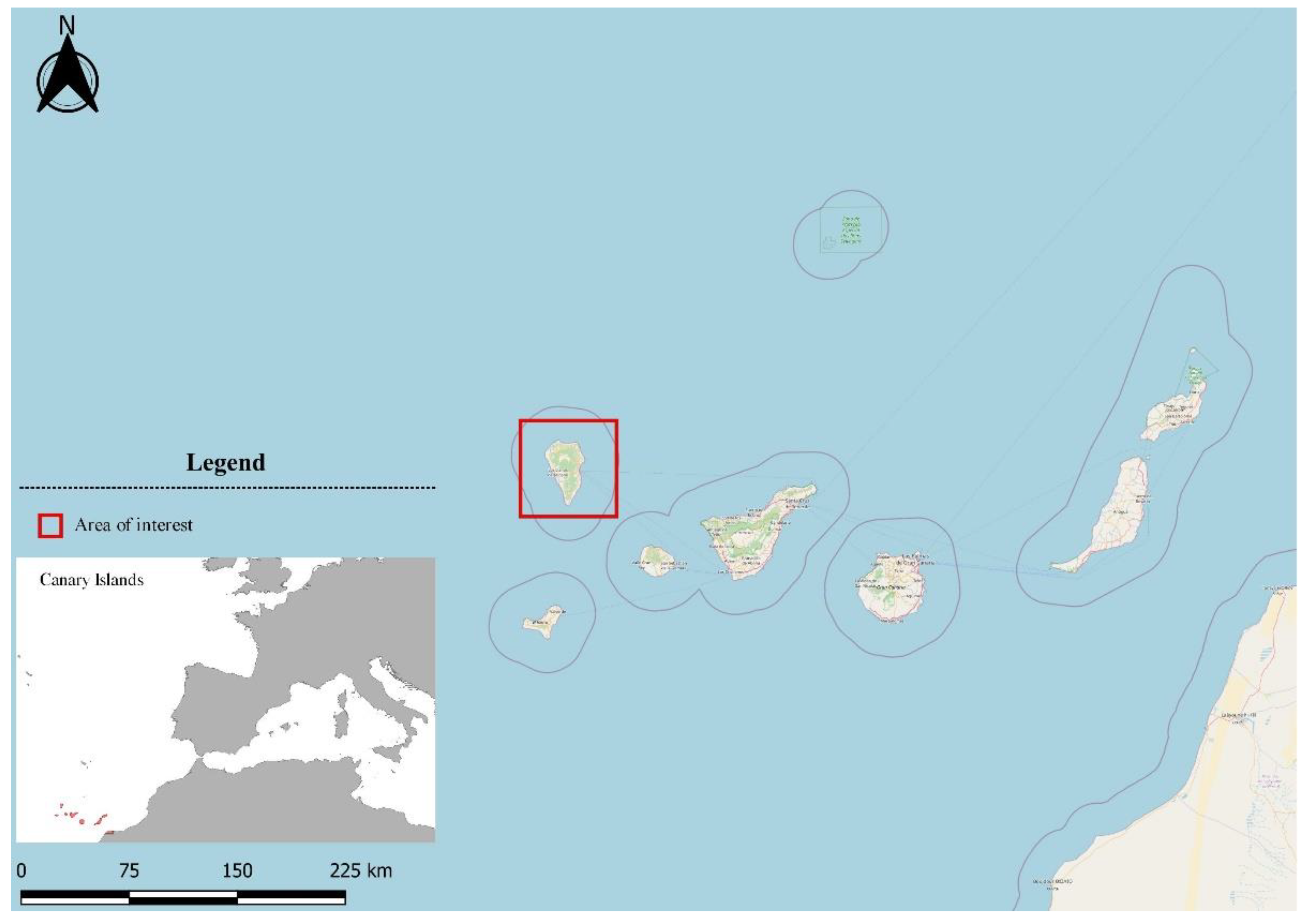



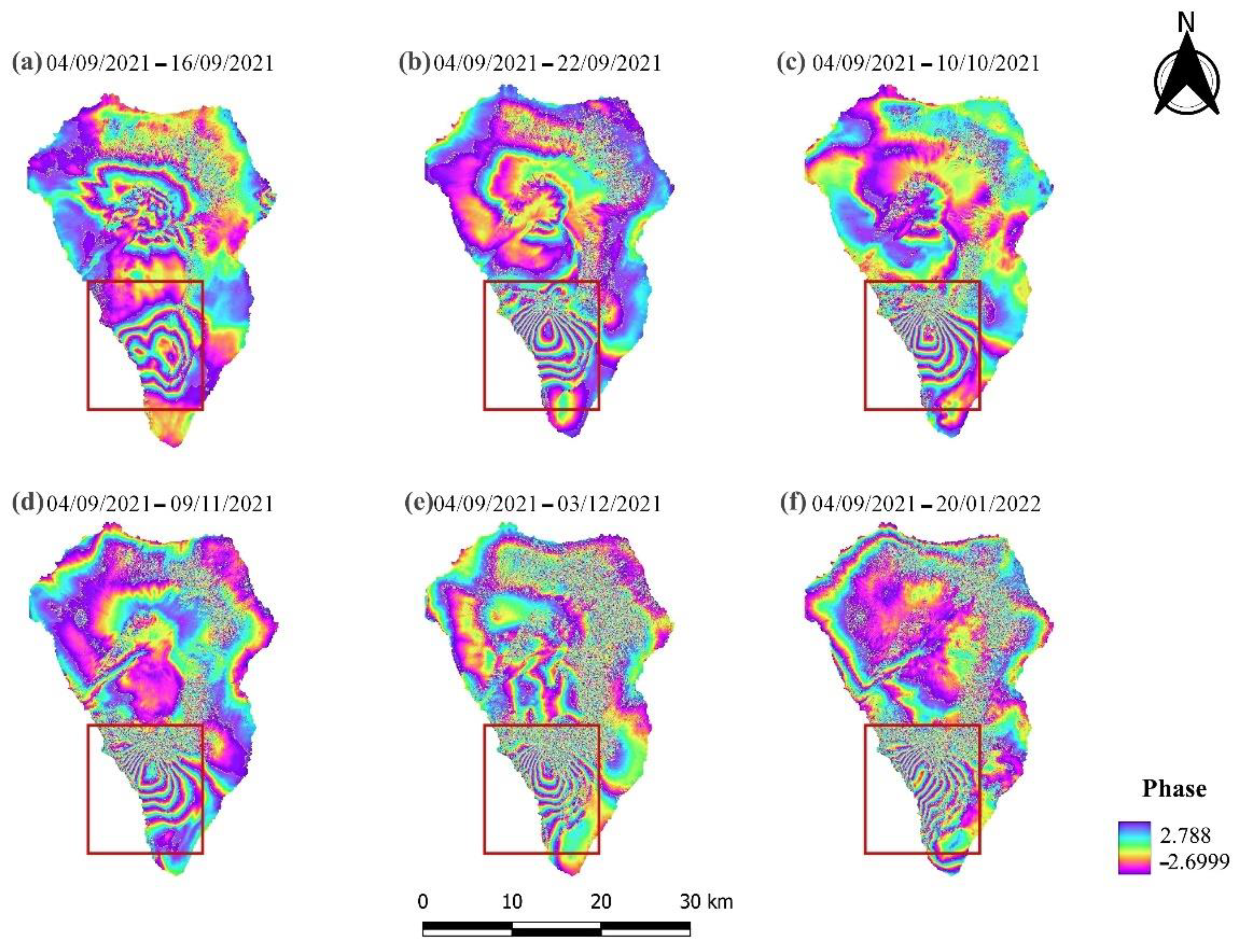

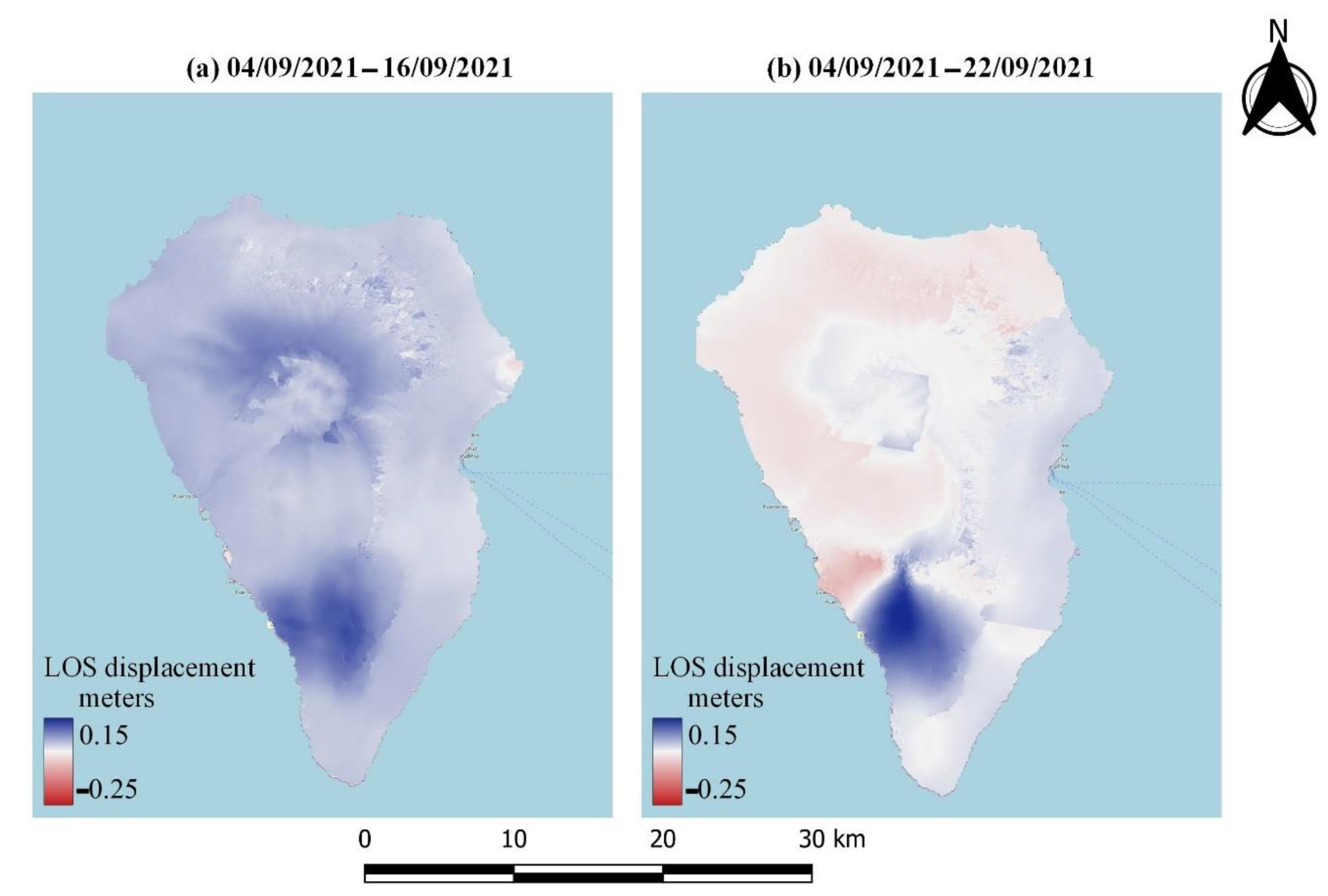
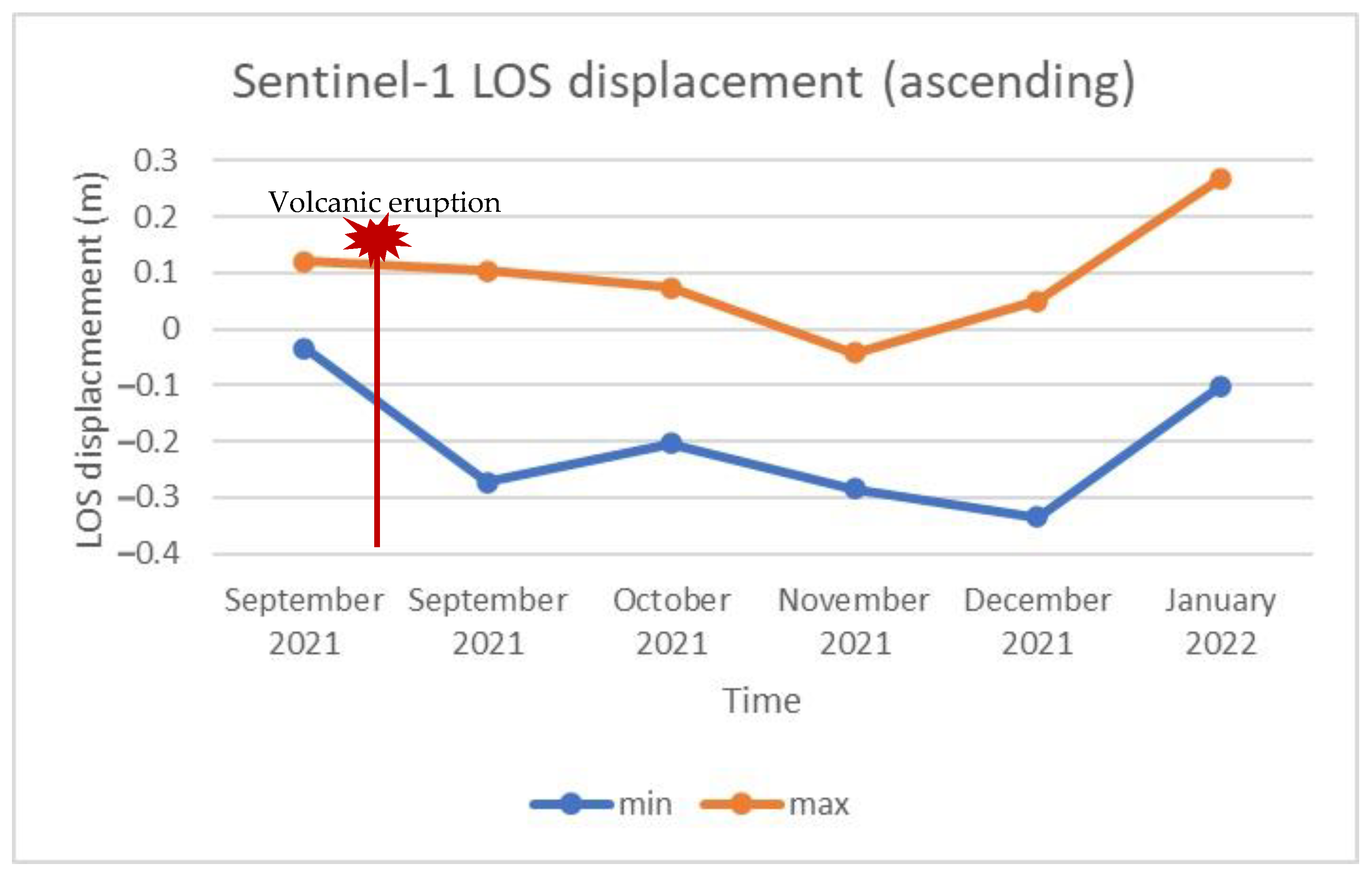
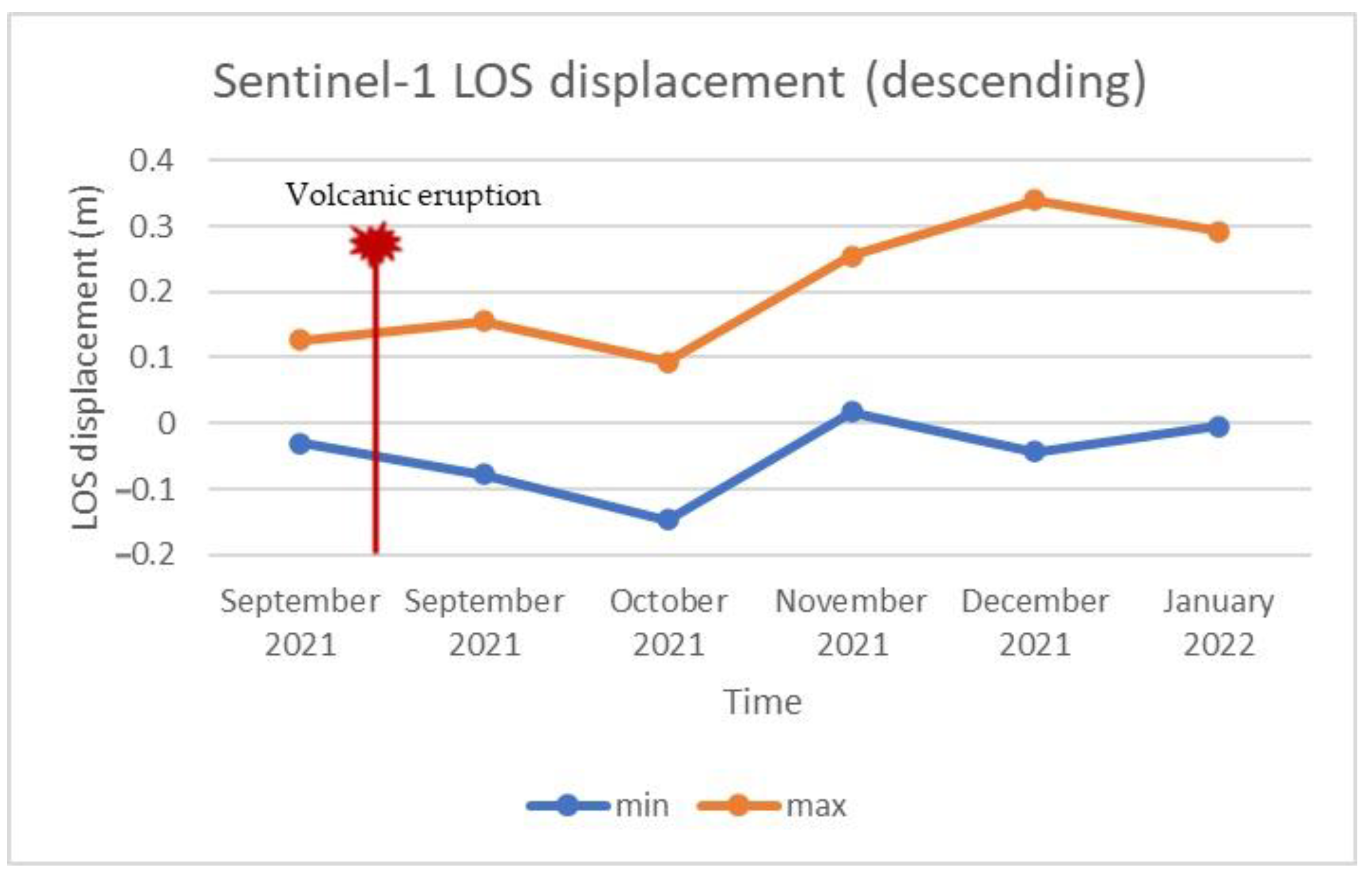
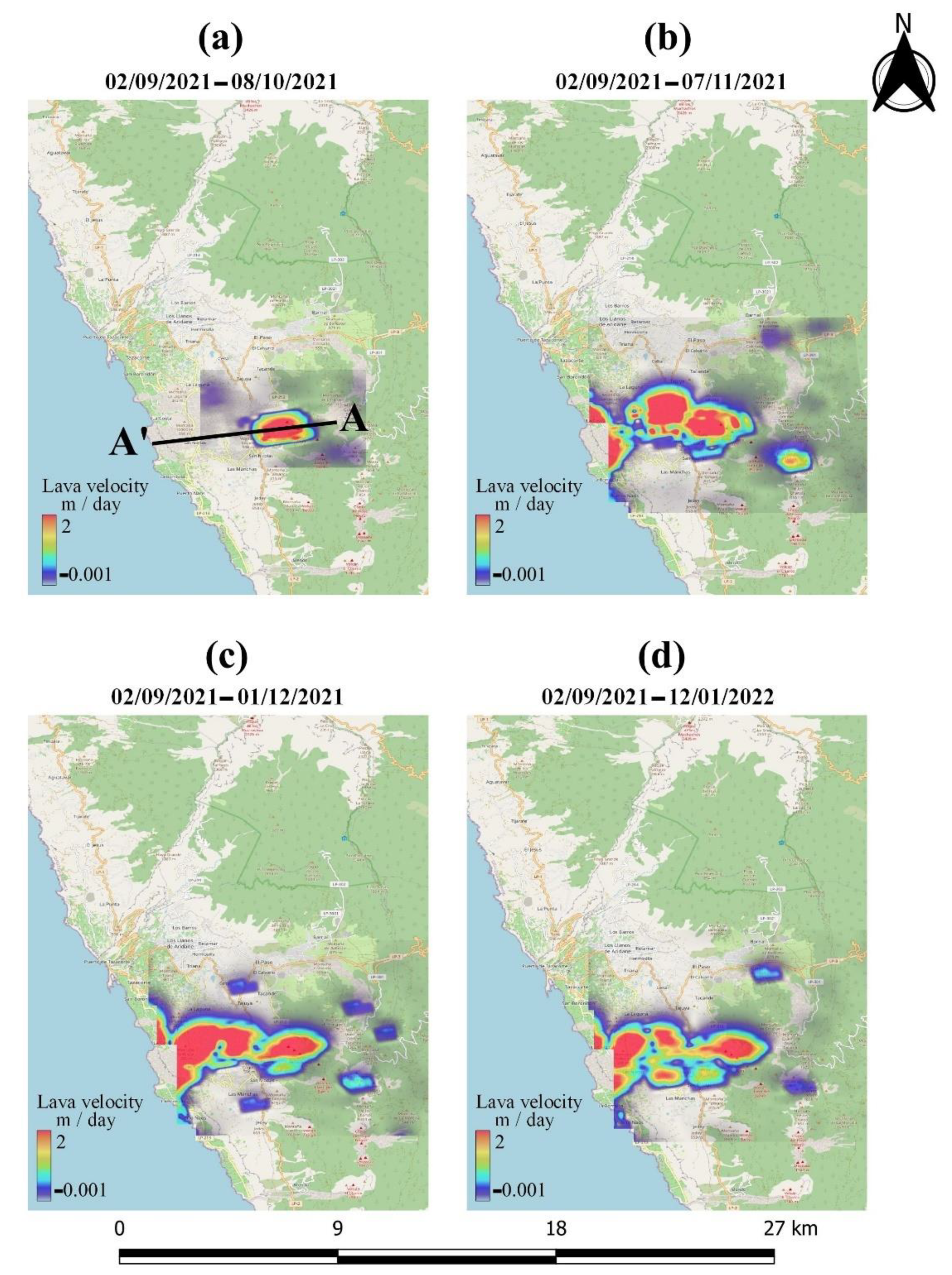

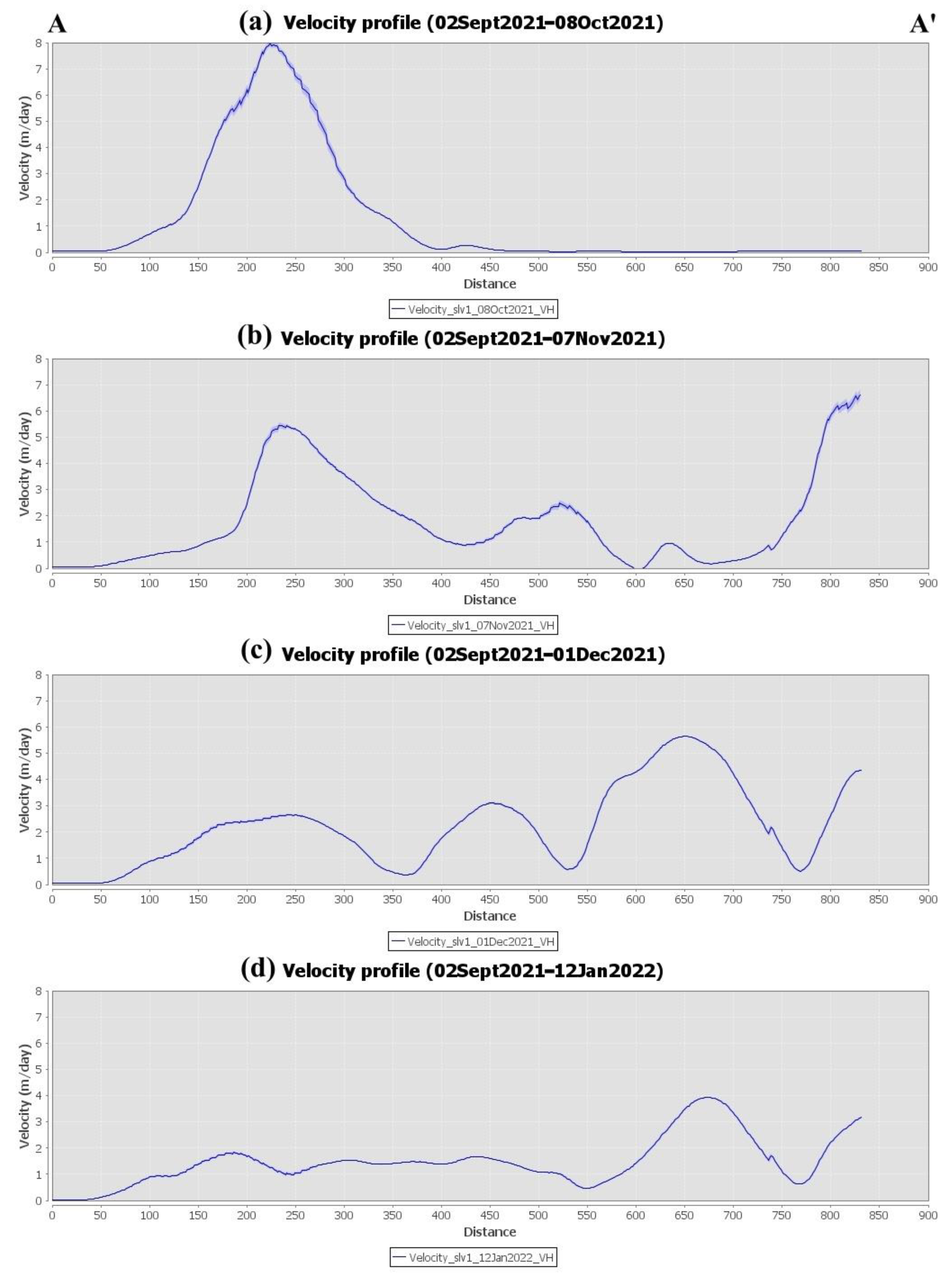

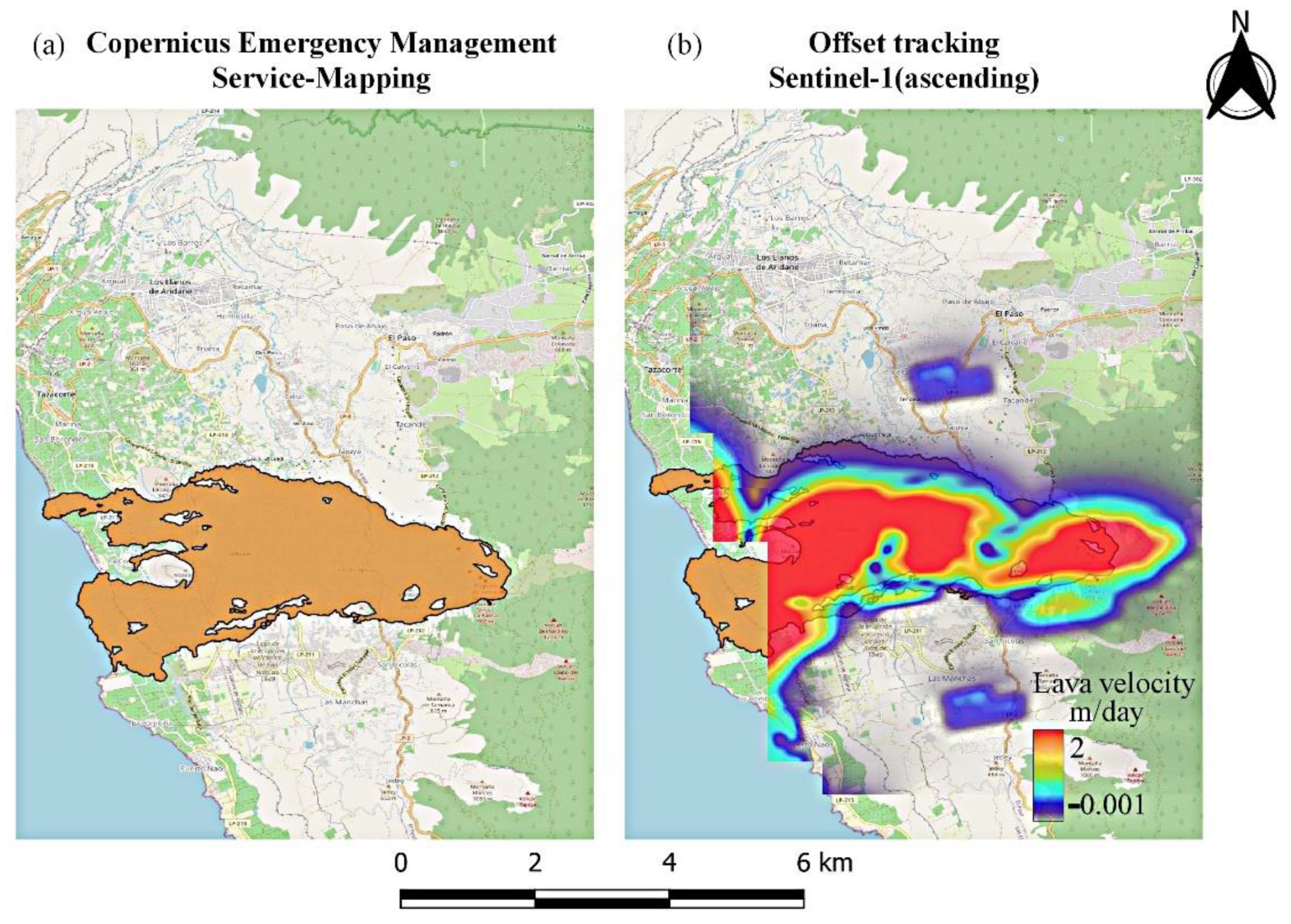
| a/a 1 | Date 2 | Mode 3 | Pass 4 | Track 5 |
|---|---|---|---|---|
| 1 | 02/09/2021 | SLC | ascending | 60 |
| 2 | 14/09/2021 | SLC | ascending | 60 |
| 3 | 20/09/2021 | SLC | ascending | 60 |
| 4 | 14/10/2021 | SLC | ascending | 60 |
| 5 | 07/11/2021 | SLC | ascending | 60 |
| 6 | 01/12/2021 | SLC | ascending | 60 |
| 7 | 24/01/2022 | SLC | ascending | 60 |
| 8 | 04/09/2021 | SLC | descending | 169 |
| 9 | 16/09/2021 | SLC | descending | 169 |
| 10 | 22/09/2021 | SLC | descending | 169 |
| 11 | 10/10/2021 | SLC | descending | 169 |
| 12 | 09/11/2021 | SLC | descending | 169 |
| 13 | 03/12/2021 | SLC | descending | 169 |
| 14 | 20/01/2022 | SLC | descending | 169 |
| 15 | 02/09/2021 | GRD | ascending | 60 |
| 16 | 08/10/2021 | GRD | ascending | 60 |
| 17 | 07/11/2021 | GRD | ascending | 60 |
| 18 | 01/12/2021 | GRD | ascending | 60 |
| 19 | 12/01/2022 | GRD | ascending | 60 |
| 20 | 04/09/2021 | GRD | descending | 169 |
| 21 | 10/10/2021 | GRD | descending | 169 |
| 22 | 09/11/2021 | GRD | descending | 169 |
| 23 | 03/12/2021 | GRD | descending | 169 |
| 24 | 08/01/2022 | GRD | descending | 169 |
| a/a | Interferometric Pair | Mode | Pass | Track | Baseline (m) | Coherence | |
|---|---|---|---|---|---|---|---|
| 1 | 02/09/2021 | 14/09/2021 | SLC | ascending | 60 | −49.59 | 0.95 |
| 2 | 02/09/2021 | 20/09/2021 | SLC | ascending | 60 | 47.90 | 0.94 |
| 3 | 02/09/2021 | 14/10/2021 | SLC | ascending | 60 | −41.53 | 0.93 |
| 4 | 02/09/2021 | 07/11/2021 | SLC | ascending | 60 | 3.57 | 0.94 |
| 5 | 02/09/2021 | 01/12/2021 | SLC | ascending | 60 | 94.97 | 0.84 |
| 6 | 02/09/2021 | 24/01/2022 | SLC | ascending | 60 | 22.88 | 0.85 |
| 7 | 04/09/2021 | 16/09/2021 | SLC | descending | 169 | 5.85 | 0.98 |
| 8 | 04/09/2021 | 22/09/2021 | SLC | descending | 169 | −9.06 | 0.98 |
| 9 | 04/09/2021 | 10/10/2021 | SLC | descending | 169 | −36.00 | 0.95 |
| 10 | 04/09/2021 | 09/11/2021 | SLC | descending | 169 | 27.08 | 0.92 |
| 11 | 04/09/2021 | 03/12/2021 | SLC | descending | 169 | 47.75 | 0.88 |
| 12 | 04/09/2021 | 20/01/2022 | SLC | descending | 169 | 28.98 | 0.85 |
| a/a | Offset Tracking Pairs | Mode | Pass | Track | |
|---|---|---|---|---|---|
| 1 | 02/09/2021 | 08/10/2021 | GRD | ascending | 60 |
| 2 | 02/09/2021 | 07/11/2021 | GRD | ascending | 60 |
| 3 | 02/09/2021 | 01/12/2021 | GRD | ascending | 60 |
| 4 | 02/09/2021 | 12/01/2022 | GRD | ascending | 60 |
| 5 | 04/09/2021 | 10/10/2021 | GRD | descending | 169 |
| 6 | 04/09/2021 | 09/11/2021 | GRD | descending | 169 |
| 7 | 04/09/2021 | 03/12/2021 | GRD | descending | 169 |
| 8 | 04/09/2021 | 08/01/2022 | GRD | descending | 169 |
Publisher’s Note: MDPI stays neutral with regard to jurisdictional claims in published maps and institutional affiliations. |
© 2022 by the authors. Licensee MDPI, Basel, Switzerland. This article is an open access article distributed under the terms and conditions of the Creative Commons Attribution (CC BY) license (https://creativecommons.org/licenses/by/4.0/).
Share and Cite
Kyriou, A.; Nikolakopoulos, K.G. Lava Mapping Using Sentinel-1 Data after the Occurrence of a Volcanic Eruption—The Case of Cumbre Vieja Eruption on La Palma, Canary Islands, Spain. Sensors 2022, 22, 8768. https://doi.org/10.3390/s22228768
Kyriou A, Nikolakopoulos KG. Lava Mapping Using Sentinel-1 Data after the Occurrence of a Volcanic Eruption—The Case of Cumbre Vieja Eruption on La Palma, Canary Islands, Spain. Sensors. 2022; 22(22):8768. https://doi.org/10.3390/s22228768
Chicago/Turabian StyleKyriou, Aggeliki, and Konstantinos G. Nikolakopoulos. 2022. "Lava Mapping Using Sentinel-1 Data after the Occurrence of a Volcanic Eruption—The Case of Cumbre Vieja Eruption on La Palma, Canary Islands, Spain" Sensors 22, no. 22: 8768. https://doi.org/10.3390/s22228768
APA StyleKyriou, A., & Nikolakopoulos, K. G. (2022). Lava Mapping Using Sentinel-1 Data after the Occurrence of a Volcanic Eruption—The Case of Cumbre Vieja Eruption on La Palma, Canary Islands, Spain. Sensors, 22(22), 8768. https://doi.org/10.3390/s22228768








